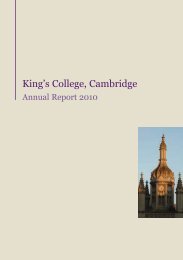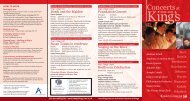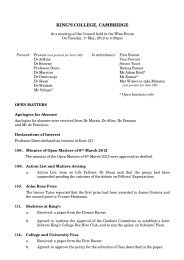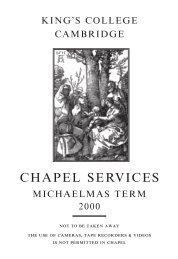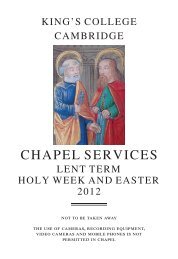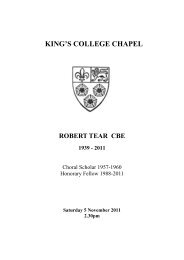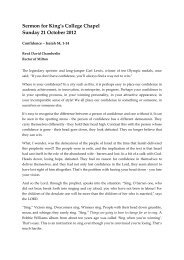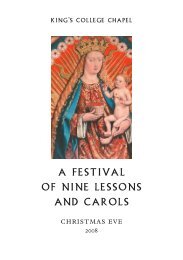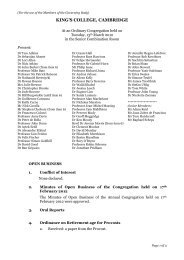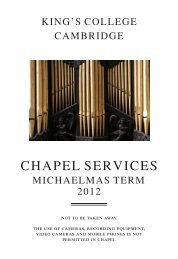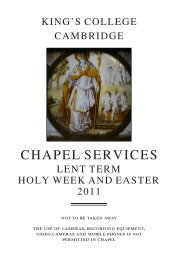Part 2 (Obituaries) - King's College - University of Cambridge
Part 2 (Obituaries) - King's College - University of Cambridge
Part 2 (Obituaries) - King's College - University of Cambridge
You also want an ePaper? Increase the reach of your titles
YUMPU automatically turns print PDFs into web optimized ePapers that Google loves.
PETER HOLLINS (1972) was born in Derby on 23 September 1953. He<br />
attended Hinckley Grammar School before coming up to King’s to read<br />
Natural Sciences. Peter was a scholar who won numerous prizes and<br />
graduated with a First. After obtaining a PhD from the <strong>University</strong> <strong>of</strong> London,<br />
Peter moved on to the <strong>University</strong> <strong>of</strong> Reading where he became a Reader in the<br />
Department <strong>of</strong> Chemistry.<br />
His principal research interest was surface science, where infrared<br />
spectroscopy was <strong>of</strong> particular value since it <strong>of</strong>fered a unique means <strong>of</strong><br />
studying surface species over a wide range <strong>of</strong> ambient pressures. Peter was<br />
part <strong>of</strong> a group that led the development <strong>of</strong> a new infrared beamline at the<br />
Daresbury Synchroton Radiation Source, enabling the mapping <strong>of</strong> the<br />
chemical makeup <strong>of</strong> materials. This has a wide range <strong>of</strong> applications from<br />
medicine to space science. He was also involved in a project examining how<br />
chips absorb fat, with the ultimate aim <strong>of</strong> developing a low-fat chip.<br />
Peter died on 28 March 2005.<br />
HUGH CHARLES HOLMAN (1943) was born in Hayes, Kent, on 13 April<br />
1925 and was educated at the Dunstable School. He came up to King’s to read<br />
Engineering in 1943 but his studies were soon interrupted by the war. Like<br />
many <strong>of</strong> his fellow students at King’s he joined the RAF and trained as a pilot,<br />
but was lucky enough not to have to test his skills in real battle. In 1945 Hugh<br />
was able to resume his studies at King’s, though in Natural Sciences as the<br />
Engineering course had no more spaces. From his days at the RAF Hugh had<br />
gained a passion for flying and while at King’s he continued in the Volunteer<br />
Reserve <strong>of</strong> the RAF as well as in the <strong>University</strong> Gliding Club. In his future<br />
career Hugh was to travel all around the world, but it was <strong>Cambridge</strong> that he<br />
remembered as the most beautiful and happiest place <strong>of</strong> all that he had<br />
ever visited.<br />
After graduating in 1950 Hugh started working in industry, first as a research<br />
chemist and then as a research metallurgist. But already by 1953 he was back<br />
up in the air, this time as a pilot for BOAC. Hugh spent some 12,000 hours<br />
143<br />
OBITUARIES



